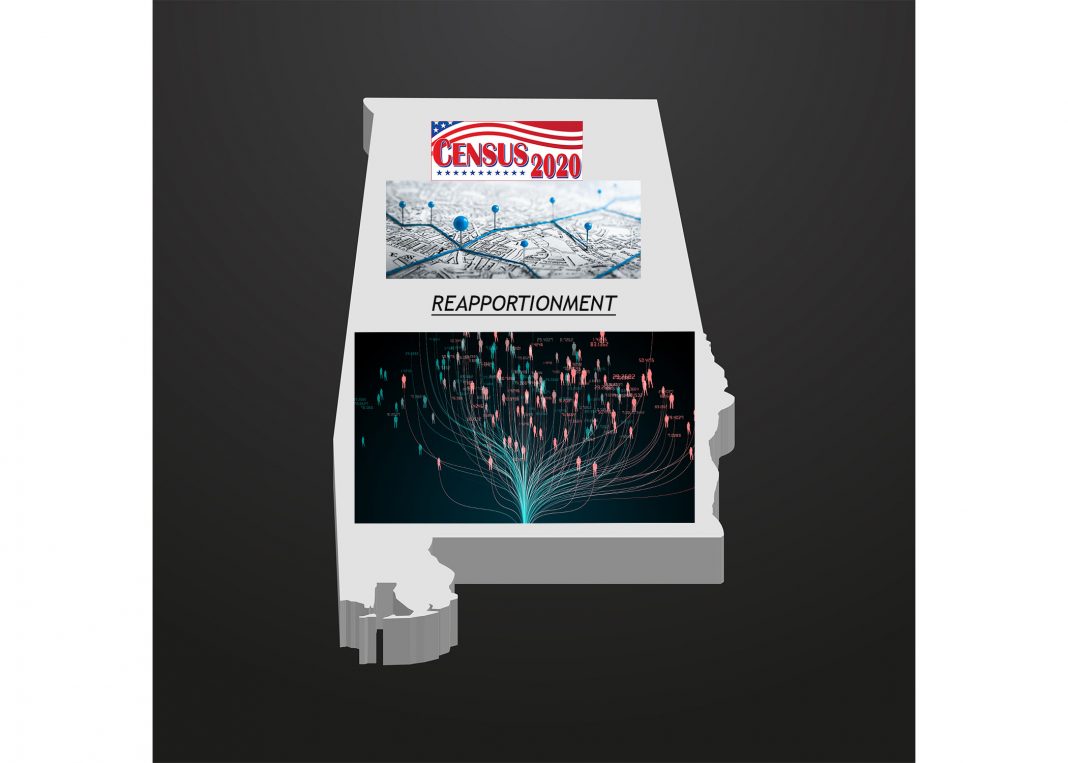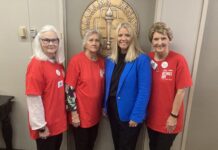FOR IMMEDIATE RELEASE
September 20, 2021 CONTACT
Written By: Kendra Majors of Alabama Values
Week three public hearings recap , scheduled hearings times; Alabamians challenge Legislature on transparency hearing ends abruptly The final week of redistricting public hearings wrapped up on Thursday, Sept. 16. There were just seven public hearings during this week.
COASTAL ALABAMA COMMUNITY COLLEGE, THOMASVILLE, ALA. | Sept. 15, 9 a.m.
Rep. Thomas Jackson said, “We are losing people in our districts in the Southwest corner, how much do we maintain the wholeness of our county lines and our city borders” Jackson lives in Thomasville and represents Clarke, Conecuh, Marengo, and Monroe counties, and he wanted the committee to answer how they would pick up the additionally needed population to meet the criteria for ideal population. Dorman Walker, attorney for the reapportionment committee, told her would have a meeting with Randy Henneman, who is the Alabama Legislature’s map creator, and he could discuss it with him. “How are we going to implement the districts as it relates to boundaries of the past, you’ve put most of the black people in the same district — stacked and packed,” he said. “How much leeway could we have to spread some people out to get the numbers that we need to have one man, one vote.” There was no response to Jackson’s question other than “thank you for your comment.” Barbara Hudson of Thomasville, who said she represents civic organizations in surrounding areas, asked the committee to respectfully answer Rep. Jackson’s question to the best of their ability.
Walker said that previously, the legislator drew the majority-minority districts first to comply with Sections 2 and Sections 5 of the Voting Rights Act of 1965. (Section 5 was struck down in Shelby County v. Holder) Walker said new supreme court cases have made it where they cannot draw based on race. So, the Legislature does not turn on that function on the map drawing software. But they would step back and see if the legislature needs to look at race to comply with Section 2 of VRA. Then, Walker said, they might choose to add black citizens to a district to get a BVAP that gives the citizens of the district the ability to participate in the electoral process. “We’re drawing districts without regard to race,” he said. “Although, I will say that obviously there are places in the state where if you draw a district just on the basis of geography, you’re going to wind up with a fairly high black population, and it’s not because blacks are packed into the district on intent.” Catherine Davies asked who is drawing the maps for the committee. The maps are being drawn by the legislature in consultation with Randy Henneman, a map drawer, who has worked with the Legislature before. Walker also stated that individual legislators could be drawing their own maps. Felicia Scalzetti asked how the Legislature will draw a majority-minority district if the legislature can’t look at race if they won’t know where black citizens are. Walker said they won’t look at the black population until the end and then see if they need to make adjustments to comply with Section 2 of VRA.
WALLACE STATE COMMUNITY COLLEGE, HANCEVILLE, ALA. | Sept. 15, 11 a.m.
Gary Holt, Hayden resident in Blount County. He said his representative lives in Jasper, but District 34 rep. doesn’t live five miles from his house. He asked to redistrict Bullock County to be in District 34. “I’ve lived there 43 years. and I’m happy living in Blount County,” he said. “We have a representative that lives in another county and we never see her.” Phyllis Shirley, who lives in the Susan Moore area said she was very concerned about Blount County being represented with four different districts. She said that if they want some kind of education reform, they have to contact four districts. Blount County is represented in District 11 by Rep. Randall Shedd; District 13 by Rep. Connie Rowe; District 27 by Rep. Wes Kitchens and District 34 by Rep. David Sandridge. She said District 34 and District 11 representatives are responsive, but the other two representatives are not. Her request was for Districts 34 and 11 to include Blount County. Shirley said the people of Blount County would be better represented. Lonna Dillard said she lives in Blount County specifically in Hayden and said her home is in District 13. She said the representative in Sandbridge lives, works, and goes to church in her community.
Dillard said Rowe doesn’t come to their community. She requested having a representative that represents their community. Wes Dilliard spoke next. He said they live in the far west end of Blount County. He said he would like to be represented in Blount County. “We are not part of Walker County,” he said. Robert Sanford said he lives in Blount County on the West side of Interstate 65. I-65 basically divides District 13 and District 34. He said it also divided a commission district which makes it difficult for the commission to have to deal with two representatives. He requested to move the Blount County portion of District 13 to District 34. Delores Fort of Blount County’s Smoke Rise community spoke next. She said that she felt that all of Blount County should be represented by one representative. She said that Smoke Rise is divided and is represented by two state representatives. Haley Czarnek asked what process the committee planned to do to abide by the VRA’s nondiscrimination requirement. Walker said that Section 2 of the VRA and the maps will be looked at to see if they have evidence of packing or cracking. He said they will be looked at from several points of view. “The districts are being drawn in a race-blind minor,” he said. She also asked who would be looking at the maps to make that determination. Walker said he would, along with members of the state’s attorney general’s office, a fleet of plaintiff officers. He said the public has a right to comment on that during the public hearings. Kendra Majors asked him when during the special session would public hearings be held. Walker said that during the special session, public hearings will be held toward the beginning of the special session. Notification of that will be on the Legislature’s website and the Secretary of State’s office, he said. Walker said he did not know how soon the special session public hearings would be announced and the public should just pay attention to the Legislature’s website.
GADSDEN STATE COMMUNITY COLLEGE, GADSDEN, ALA. | Sept. 15, 2 p.m.
Kent Back submitted a letter on behalf of a friend Priscilla Youther, who said that Elkmont High School and its elementary school are in two different districts. The letter said that not many educators know who represents them on the state board of education. The letter said that currently, she could not see how the state board of education was bettering students. Youther is a long-time educator.
Kirkland Back, an attorney in Gadsden and life-long resident, said Etowah County is such a microcosm of what is going on in the state. She asked how they are planning to comply with Section 2 of the VRA given the criteria set out for them. She brought up 12 identifying factors. Walker said those are brought into play if a case is brought. “We’re concerned, we’re worried about our minority populations here in Northeast Alabama, we want to protect their vote as much as we can,” she said. “We want to protect taxpayer dollars. We want to protect them from ever having to bring a suit. We think we can do that by getting this right the first time around.” Rep. Craig Lipscomb said he wanted to echo what Mr. Back said. He said his constituents have asked him to retain the existing school board lines that currently include Etowah County. Kendra Majors asked, “What criteria will you use to determine when to split counties and voting precincts?” Walker said, “Counties and voting precincts will be maintained to the extent possible. They are most likely to be split to achieve population equality.” Angelica Mamani said she just recently became aware of these meetings. She said she has a hard time understanding how the current districts are drawn. She asked what explanation will be given for the reasoning. Walker said the foundation of redistricting is a census block. He said there are voting precincts and the Legislature does its best not to split precincts and counties. He said if they have to do that, it will be along with precincts. He said that may be why you have a high school on one side and an elementary school on the other. He told her to pay attention to the plans when introduced into the legislature and then email her legislator and ask questions. Robyn and Vince also asked why the public hearings were scheduled during working hours. Walker said they would take that into consideration for 2031. He said they were under a time constraint. Majors also asked for clarification on when testimony was due since it was stated in the Dothan Hearing that maps would be due on Sept. 16. Walker said, “There is not really a deadline to submit comments. Testimony is given in these hearings. If you want to send a message to the reapportionment committee expressing your thoughts on plans or parts of plans to be drawn, you can do that and they will, as they come in, put them in a folder that will be posted on the Internet with the transcripts.”
NATIONAL GUARD ARMORY, UNION SPRINGS, ALA. | Sept. 15, 4 p.m.
In Union Springs everyone who attended the meeting spoke to the reapportionment committee. Guy Trammell spoke first. He said he was from Macon County. He said his house district is joined between Macon and Bullock County. He said that Macon County doesn’t have a hospital, but Bullock County does and the health aspects are similar between the two counties. He also said the two counties share economic development opportunities. “Together they can work together to increase economic development and really take us to the next level for the 21st Century. We even look at technology. We’re moving for the 21st Century.” He mentioned bringing in fiber optic and broadband, telehealth, and more. He said he felt it was better for both communities if they both were in the same district. Rep. Pebblin Warren said as has served District 82 since its existence. She said she doesn’t have a racial breakdown on the race of her district. Walker told her that information is available. Warren said the way the district is drawn now is very Gerrymandered. She said she has to cross another district to get to the rest of her district. “I hop and skip and I’m hopping and skipping because of the racial-ethnic of the people in the areas,” she said. “It’s quite obvious anybody can look and see I’m not consistent and that break is because of a racial break in there. I’m asking that whatever we do this time we make it half-way convenient for the legislator who serves.” She said that she has to cross three districts. Walker said the total population of District 82 is 52,664 of which 47.23 percent is black and 43.39 percent is white. Commissioner John McGowin said Bullock and Macon counties have been together since the last reapportionment. He said that Bullock County was made from Macon County. “I would like to see Bullock and Macon County drawn together if at all possible,” he said. Michael Johnson said he is in total agreement with including Macon and Bullock County in one district. Currently, District 82 includes all of Macon County and portions of Lee and Tallapoosa. Kendra Majors asked for clarification on how long constituents had to submit maps and public record after it had been said at the Dothan meeting that the deadline was Sept. 16. Walker said, “ Obviously the sooner you get them in the better. If you send them in they will be placed in public record up until the start of the legislative session. If you want someone to look at them, though, you need to give them time to look at them, so go ahead and send them in.” Shalin Moody said that it was stated that the whole county map had too high of a deviation, and asked what percentage is considered a high deviation.
Walker said the proposed plan by the League of Women Voters has a deviation of 3.4 percent, which he said is unusually high for a congressional plan. Jim Blacksher who is one of the attorneys working with the League of Women Voters said that the actual maximum deviation of the LWV’s map is 2.47 percent. He said it is not an estimate, it is actually what you get when you put the official Census data into the maps. Blacksher did say that when the map was created using 2020 data that wasn’t official Census data, it was closer to a 3.5 percent deviation, but the official numbers give the lower deviation.
UNIVERSITY OF WEST ALABAMA, LIVINGSTON, ALA. | Sept. 16, 11 a.m.
During the Livingston public hearing, the committee became noticeably frustrated as attendees asked deep-diving questions regarding the process and accessibility of the hearings. Some of the responses from the committee included abruptly ending the hearing, ignoring comments, and the hearing officer instructing the court reporter to not read certain comments on the public hearing schedules. Lucious Black Jr. said he was concerned about the equality of population and asked more about what that means. Walker asked if he understood the concept of ideal population, which means they take the total population and divide it by the number of senate seats, house districts, state school board seats, or Congressional districts, which gives them the number of people that should be in each group. Right now, the legislature will have to expand or condense their boundaries depending on the loss of population or increase of population, he said. Walker said the variation allowed it plus or minus 5 percent. Black said that Walker may have confused him a little bit. “You talked about ideal population but I’m not quite clear of the meaning of ideal population, unless that means a number category or something,” Black said. Walker explained how the Legislature arrives at the ideal population again. “Because we are allowed when we do State Board of Education, Senate and House districts to have some variation that we are not allowed to have when we do Congressional districts,” Walker said. John Zippert of the Alabama New South Coalition and other progressive efforts in Greene County said that the Legislature should take a strong look at the League of Women Voter’s map. “The maps they have drawn, I think, would enable us based on the fact that about a quarter of the population is composed of African Americans; gives us the potential opportunity to elect two African Americans to Congress,” he said.
He also requested for the House of Representatives map to include Greene and Sumter counties in the same district. Greene County is split between Districts 71 and 72, currently. He said he did not feel that splitting Greene County was the best for the county. Haley Czarnek corrected Walker’s statement that the tab on the legislature’s website says
“redistricting.” It actually says “reapportionment.” Kendra Majors asked, “Will you be filtering out comments that are deemed out of the scope of the redistricting process? If so, who will be responsible for determining what is out of scope?” Walker said, “I’m not sure what that question is. The court reporter is taking down everything that is said and that will be the record of the hearing. The court reporter has a duty to record everything accurately and she will attest at the end of the transcript that is what she has done.” Felicia Scalzetti then commented, “Mr. Walker stated earlier that this cycle had the most reapportionment public hearings that has ever been held, but to my count, there were 29 public hearings in 2011, of which, 10 of those hearings were held after working hours. This cycle we have had 28 hearings and only one has been after working hours.” Walker replied, “Thank you.” Czarnek then asked how incarcerated people are counted. Walker said, “Incarcerated people are counted or were counted rather just like anyone else. Maybe your question is ‘are incarcerated people counted as in the location where they are incarcerated or where they maintain a residence if they maintain a residence in Alabama.’ For example, there is a prison in Elmore County. Are the prisoners counted as part of the population of Elmore County or if there are prisoners there that have residences in Autauga or Etowah or whatever are they repatriated to those for Census purposes?” Walker said that Alabama does not do repatriation. Majors also asked why the committee elected to change the schedule if it was so different from 2011. Walker said they increased the number of hearings at the request of the committee and wanted to take advantage of the ability to have remote hearings. As a fact check, Scalettzi’s comment about the number of hearings being the highest in 2011 is accurate. Walker’s statement about there being more hearings this current cycle is inaccurate. Cznarek asked Walker how people would submit comments after the public hearings, especially if they don’t live in Montgomery.
Walker said comments can be submitted right now. He told her she was participating in the hearing, now is the time for her to submit a comment. She could also email something to the reapportionment committee and it would be put into the record.
Majors asked why the committee elected to only have one after working hours hearing if they had 10 in 2011. Walker said, “Kendra, the purpose of this hearing is to solicit comments about how districts should be redrawn, if you want to make a comment about that that would be helpful.” Cznarek asked, “It took over a year last time to redistrict, why are we rushing this process before the final Census data is out on Sept. 30?” Walker said, “Actually what happened last time is that we had two bites at the apple in redistricting. We had to conduct Congressional and state board of education redistricting in 2011 because they had elections in the next year, but the legislative elections were not in the next year, so we were able to do legislative redistricting in 2012.” Walker said all of them are in the next year, which is why they need to be done now. He also said that the data was released in the Legacy format in August. Cznarek asked, “How do we make these maps without the full data? We do not have to use these maps for the next election is my understanding.” Walker said, “Haley, we have all the information that the Census Bureau is going to put out, they will just put it out in a different form.” Majors said, “If the purpose (of the hearings) is to solicit comments from Alabamians, the hearing has to be accessible. My question is why did you give a schedule that is inaccessible to most working Alabamians?” Walker said, “Kendra, it is clear that you have a problem with the schedule and you have made your point on that.” Scalzetti said, “To follow up on the point I made on the schedule, during the hearing yesterday Mr. Walker stated that complaints about the scheduling of the hearing during working hours that the committee would look into having evening hearings in 10 years. However, we already had evening hearings in 2011. There is no reason to change it this cycle and then change it back in 2030.” Following this comment, Walker directed Donna Overton not to read any more comments about the schedule. “Don’t read any more comments about the schedule,” he said. “If people have comments that are helpful and remain to the purpose of the hearing please read those.”
Scalzetti told the committee that since the Census data came out on Aug. 12 and the hearings starting on Sept. 1 that did not give people enough time to come up with their own maps and plan. Czarnek said citizens need the full data to make maps.
Walker pointed her to Dave’s Redistricting and other software as well as Alabama State University where she and others could create their own maps now. “The real purpose of this hearing, however, is to receive information on how citizens want maps drawn, which does not require anything other than the information about how districts need to change their shape,” said Walker.
COASTAL ALABAMA COMMUNITY COLLEGE, FAIRHOPE, ALA., | Sept. 16, 2 p.m.
Freya Sunnenstein spoke as a member of the League of Women Voters. She said that Baldwin County has experienced massive growth. In fact, it is the fastest-growing in Alabama and the seventh in the U.S. She urged the committee to correct the inequities in the maps currently, citing non-compact districts and minority packing. Former Rep. Bradley Byrne spoke next. He said that Senate district 32 has grown and the district was designed to keep a community of interest together of those who live along the Eastern Shore down to the beach communities in Baldwin County. He asked that the Legislature attempt to keep those communities together. On Congressional District 1 he said, “Mobile and Baldwin County need to be kept together and they need to be kept whole.” Byrne said it would be difficult for a representative to stay on top of issues if coming from other places. On redistricting of the state school board District 1 Byrne said, “I think the Legislature made a tremendous mistake when they drew District 1.” Byrne said the representative lives in Montgomery. He said that more than one person is representing the Mobile County School District. He said that’s a lot of work because of Mobile County Public Schools’ size.
He wants to put all of Mobile, Baldwin, and Escambia counties together. Dev Wakeley said to the committee, “If you have the maps in front of you, Districts 66 and 64 on the house map are real elongated.” He then explained that in District 66 the quickest way to get through it is to drive through Florida. Wakeley also said more people would be able to make the public hearing if it was after working hours. Barbara Caddell said she spoke at the Mobile County version of the hearings.
She wanted to know if there would be more hearings specifically for the school board or other districts. She also wanted to know if all of the maps would be included in the special session. Walker said the special session would be for all four maps.
Scalzetti asked if the special session would be broadcast online and if the Legislature would take public comment. Walker said it would be broadcast online but comments would not be taken.
SOUTHERN UNION STATE COMMUNITY COLLEGE, WADLEY, ALA. | Sept. 16, 4 p.m.
No one attended the Wadley meeting in person and no one spoke in the virtual chat. Two people — Haley Czarnek and Casey Daniels — posted after Walker closed the hearing they were trying to post on the chat. “I want it in the record that I tried to submit a comment, and y’all ended the meeting at 4:06 before I could get a comment in because I got kicked out of the meeting,” Czarnek said. “I agree,” Daniels said. “I was in the middle of writing a comment when they abruptly ended the call.” During the hearing, Sen. Jim McClendon and Rep. Chris Pringle, who are the co-chairs of the reapportionment committee read the normal information they provided during all the previous hearings. Unlike the previous hearings, Walker immediately asked for a sign-in sheet which was at 4 minutes, 22 seconds into the meeting, and asked if anyone wanted to speak online or give comments at 4 minutes, 34 seconds. At 4 minutes, 47 seconds, Walker gave the last call for comments and closed the hearing at 4 minutes, 59 seconds, based on the Alabama Values recording of the hearing. During this meeting, Walker did not read the rules set forth by the legislature as he had done in the previous hearings. For comparison, earlier in the day at the Livingston meeting, after the two legislators and Walker gave their comments and instructions, the first person was called to speak at 21 minutes, 31 seconds into the recording. (Alabama Values started recording when McClendon opened the meeting.)
OTHER INFORMATION
Anyone who has not sent in comments is urged to send them to district@alsenate.gov as soon as possible. Now, Alabamians wait for Gov. Kay Ivey to call the special session on redistricting.
Reported by Kendra Majors
Alabama Values Email: kendra@alvalues.org
Alabama Values is a state-based 501(C)(3) communications hub seeking to amplify progressive voices and policies in Alabama.














